Progressive profiling is a Pardot form feature that aids user experience just as much as it helps businesses to understand more about prospects over time.
When the same person visits your website to download a second piece of content or registers for your webinar having enjoyed the last one they attended, they shouldn’t need to fill out a form with the exact same information they shared with you in previous form submissions. It’s tedious for the user and detracts from any personalised journey you’re trying to provide.
For this reason, Pardot forms have default settings that improve how form fields display and therefore, support a better user experience and higher form conversion rates.
Tip: these settings apply to Pardot forms only, not third-party forms using form handlers. They’re partly why we recommend Pardot forms over form handlers except in unique cases.
Removing previously completed fields
Pardot forms will only show fields a prospect has not previously completed. This is a great first step to eliminating the chore of filling out the same fields multiple times. An exception is the email address field, which is required on every form submission.
It is possible to override this default display behaviour by:
- Navigating to ‘Fields’ in the form creation process.
- Selecting the pencil icon to the right of the field you’d like to override.
- Clicking the ‘Advanced’ tab.
- Marking the checkbox for ‘Always display even if previously completed’.
- Saving your form.
You might like to show previously answered fields if the answer could change over time. For example, on the MarCloud contact form we include ‘Services of interest’, and given we have many different services available, a single prospect could send multiple contact form submissions with different interests i.e. at the first point of contact they may be interested in Pardot landing page templates and six months later, looking for support with B2B Marketing Analytics.

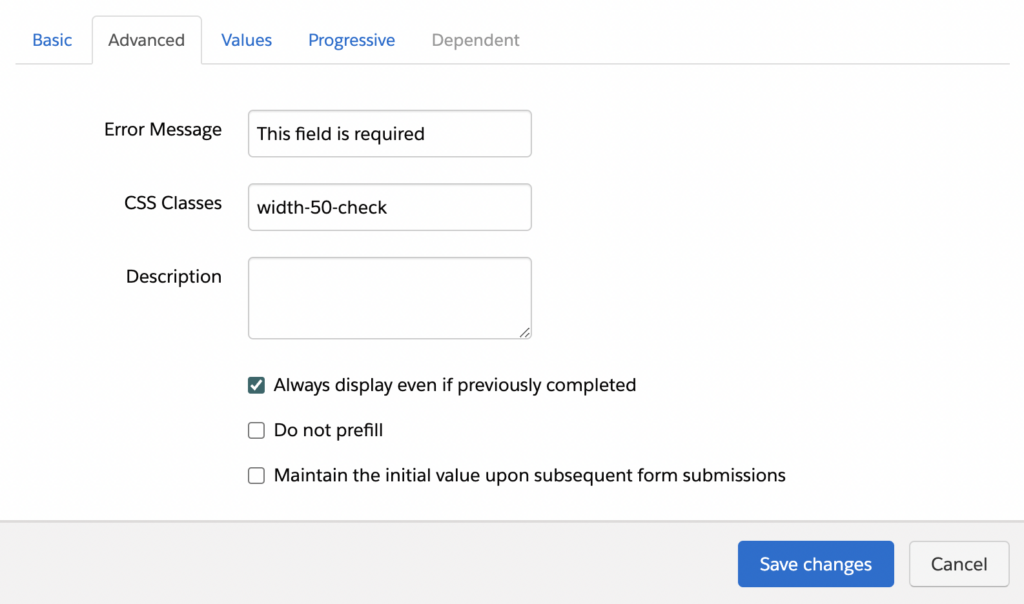
Pre-filling form fields
Another default setting is the pre-filling of form fields if a user is already cookied. Again, this prevents users from having to manually re-enter the same information i.e. their email address.
Of course, pre-filling isn’t suitable for all form fields. If the value of that field could change, you may want to mark the ‘Do not prefill’ option in your form settings. To do this:
- Navigate to ‘Fields’.
- Select the pencil icon to edit your chosen field.
- In the pop-up window, click the ‘Advanced’ tab.
- Select the ‘Do not prefill’ checkbox.
- Hit ‘Save’.
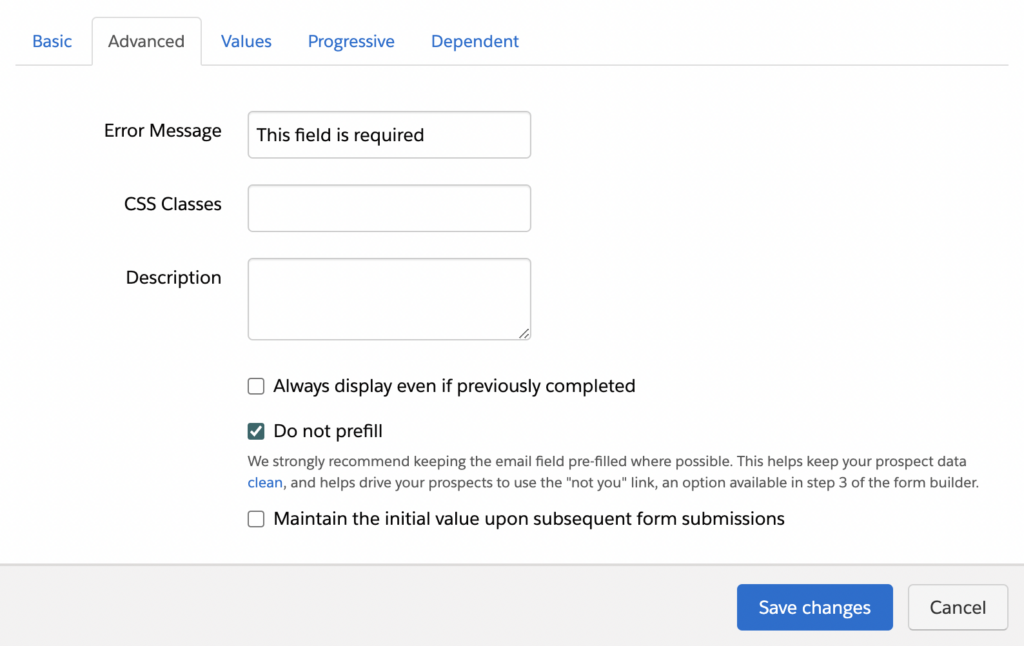
Long-form comment fields generally shouldn’t be prefilled, as an example.
Progressive profiling
Progressive profiling goes one step further than simply hiding or pre-filling fields for returning prospects. It’s a built-in feature of Pardot forms that displays new fields for known prospects, allowing you to collect more information about them.
Consider a prospect who registers for events regularly. Relying solely on default form settings, it’s likely this person will eventually see a form that consists of one field: their email address (and this is pre-filled). You know this person is highly engaged and you have the basic information you require for your events, but what more have you learned about them?
With progressive profiling, you can learn something new about a prospect each time they submit a form. New fields will be shown on the condition that the prospect has answered previous fields.
To set up progressive fields, create or edit your form and in step 2 ‘Fields’ of the process:
- Click on ‘Add New Field’.
- Enter the ‘Label’ and select the ‘Prospect Field’, ‘Type’, and ‘Data Format’ of your new question.
- Navigate to the ‘Progressive’ tab.
- Mark the checkbox to ‘Show this field only if the prospect already has data in the following field(s)’.
- Select the conditional field a prospect must have answered before seeing this field.
- Select ‘Add Another’ to include more fields that must have been answered previously.
- Hit ‘Save Changes’.
Here’s a MarCloud example:
For prospects who have previously indicated that they a) use Pardot and b) have indicated their Pardot experience level, we’d next like to know which edition of Pardot they’re using. This makes it easier for us to tailor email marketing content to include only the best tips, guides, and feature recommendations for their edition.
As you can see below, in our form field settings we’ve entered ‘Pardot Edition’ as the new field and in the ‘Progressive’ tab, selected the fields a prospect must have completed before being shown this new field.
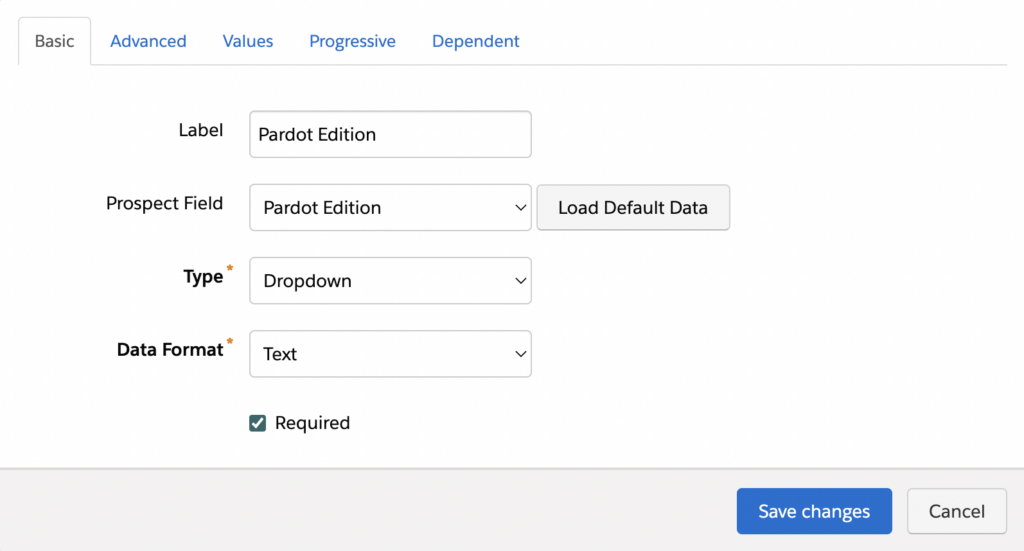
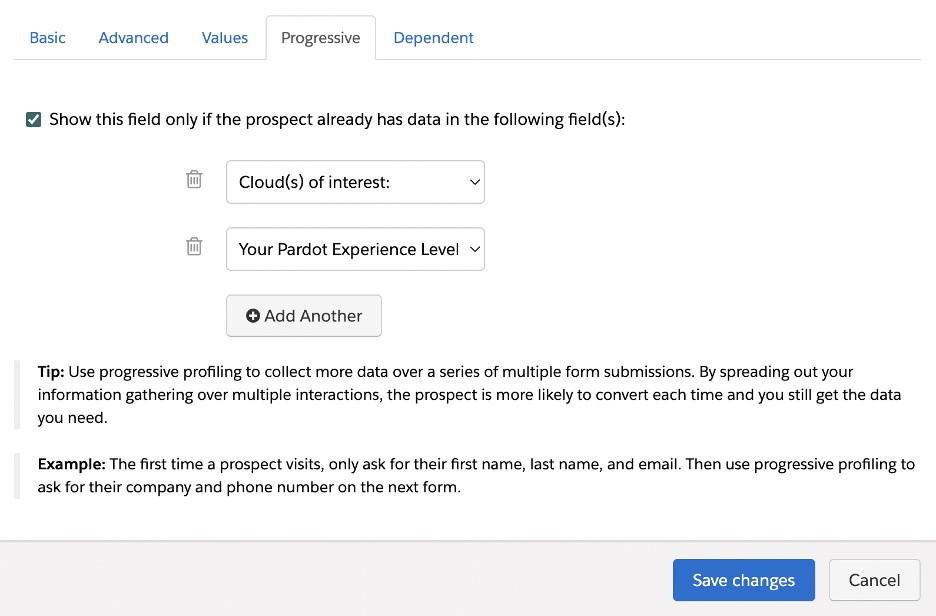
Side note: It’s not possible to use progressive profiling for the ‘Email’ field.
It’s easy to see how this progressive profiling via Pardot forms benefits businesses but bear in mind the powerful personalisation and tailored content that can be created to benefit the prospects' experience with your brand too!
The more we know about our prospects, the better we can segment and deliver relevant messaging that resonates. This creates a win-win situation whereby prospects have a high quality and memorable experience, be it on your website, in their email inbox, or during other interactions with your business, whilst you achieve higher than ever lead conversion rates.
Keen to level up your Pardot forms? Start with mapping your progressive profiling plans offline before making changes to your account. Our team of Pardot experts is available to support you, with a range of flexible consulting and campaign management options.

Anton Minnion
A data scientist and engineer, Anton has extensive experience in successfully delivering martech and salestech solutions for a variety of clients, both big and small, and across 25 countries. With a scary amount of knowledge in the development space, his focus at MarCloud is on innovating technical solutions for clients but also creating brand new apps and products for Salesforce platforms, to solve common business challenges.
More by Anton MinnionFeatured resource

Pardot Scoring & Grading That Works
This handbook gives a straightforward explanation of Pardot grading and scoring. It outlines default versus custom models and provides a basic understanding of lead qualification. If you’ve ever wondered what the difference is between grading and scoring, we cover it.
Download now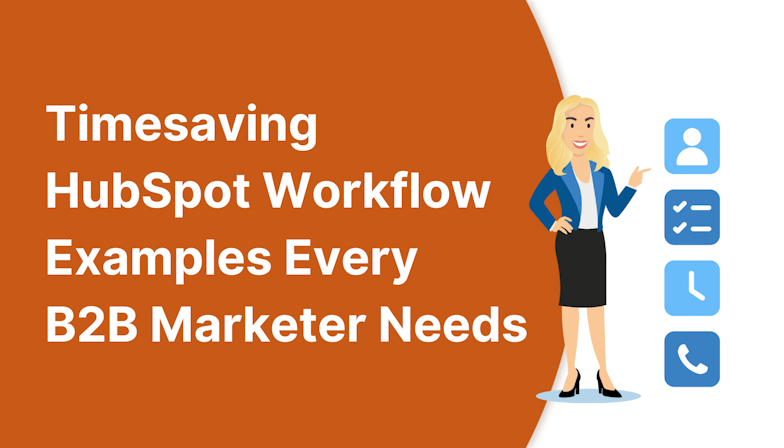

![Coloured background with text How to Measure HubSpot ROI [Free eBook]](https://www.datocms-assets.com/103555/1763939582-hubspot-roi-ebook.png?auto=format&dpr=0.5&w=1568)
